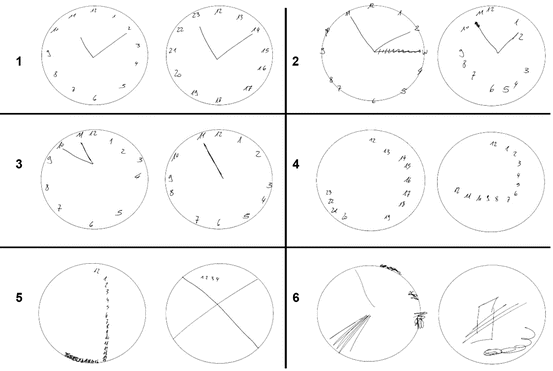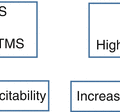Fig. 23.1
GAITRite® platinum plus version with a 610 cm long active mat and two additional inactive extensions. Mat is connected to a portable personal computer. Room is kept neutral to reduce external influences on a patient’s walking performance. Source: Centre for Memory and Mobility, ZithaSenior
In the clinical context, spatial-temporal gait analysis may serve to diagnose and to assess the severity of the underlying injury or the disease. Furthermore and even more important for the rehabilitation process is the continuous quantification of gait parameters allowing the evaluation of the effectiveness of the interventions. Interestingly, it is now suggested that (subclinical) gait changes can be used as a surrogate marker of future falls or disabilities and even future diseases [8].
23.2.4 Functional Independence Measure
The Functional Independence Measure (FIM) allows evaluating physical and cognitive functions among rehabilitation inpatients. Psychometric properties such as discriminative validity and internal consistency have been evaluated (see, e.g., [9]). A trained evaluator is ideally required to rate a total of 18 items (13 motor tasks and 5 cognitive tasks) on a 7-point ordinal scale ranging from complete dependence to complete independence. Generally, the FIM is used several times during a rehabilitation process to track a patient’s disabilities and recoveries in detail and to determine how much assistance is required for the individual to carry out activities of daily living. The quality of the assessment is directly dependent of the multitude of the gathered information. Therefore, the patient’s disabilities should be rated by a multidisciplinary team.
23.2.5 Short Physical Performance Battery
The Short Physical Performance Battery (SPPB) comprises different performance measures of lower extremity function. Gait, strength, balance, and endurance are measured using three short tests: (1) standing balance including tandem, semi-tandem, and side-by-side stances, (2) walking speed on an 8-foot walking course, and (3) repeated chair stances (five repetitions). The total administration time of the three tests in the clinical setting ranges from 10 to 20 min depending on the physical condition of the patient. The scale has been found to predict loss of motor function, impairments affecting the activities of daily living, mortality, and institutionalization. The SPPB has established reliabilities and validities for community-dwelling older adults. Research investigating the validity of the SPPB in acute hospitalized patients is available [10].
23.2.6 Tinetti Test
The Tinetti test or “Performance-oriented mobility assessment (POMA)” was developed by Mary E. Tinetti in 1986. The Tinetti test assesses balance (e.g., standing balance, turning 360°) and gait (e.g., step symmetry, step continuity) through a variety of different tasks. The tasks are scored and summed up, with lower scores indicating higher mobility impairments and thus a higher risk for falls. The test is well adapted to the clinical context as it does not require any special equipment. The administration time usually does not exceed 10–15 min. Different versions of the Tinetti test with a varying numbers of tasks and scoring systems are available. The majority of studies demonstrate that the different versions of the test are reliable and valid tools for assessing the mobility status of patients showing different medical conditions (e.g., Parkinson’s disease; [11]). Nevertheless, when employing any version of the Tinetti test, it remains crucial that the therapist is thoroughly informed on the psychometric properties of the respective version in use.
23.3 Evaluation of Cognition and Mood Disorders
The present section reviews psychometrical instruments which allow assessing cognition and affectivity of elderly patients in an economical and valid manner. Generally, a differentiation can be made between screening tests to gain a quick and broad overview of diverse cognitive functions and function-specific neuropsychological tests assessing different cognitive functions in more detail. Older inpatients should be screened for possible cognitive deficits so that rehabilitative interventions and overall care can be adequately adapted to their cognitive status. Likewise, it is important to assess the affectivity of patients so that a possible depression can be detected and treated appropriately. Furthermore, clinical-instrumental evaluation plays an important role in the differentiation between mild states of cognitive impairments (e.g., mild cognitive impairment) and more severe cognitive impairments (e.g., dementia) and mood disorders. Symptoms of all these conditions can overlap increasing the risk of misdiagnosing. In general, the neuropsychological evaluation should be preceded by an extensive clinical interview (i.e., anamnesis), so that concerns of the patient and their acquaintances can be assessed. The knowledge about those complaints is important to guide the testing process, and accurate assessment instruments are chosen.
23.3.1 Evaluation of General Cognitive Functioning
Due to limited time resources in the clinical context, there is a need for instruments which allow a relatively quick and general overview of the cognitive deficits and capacities of a patient entering the rehabilitative process. The assessment of cognitive functions is generally a complex (and may be an intimidating) situation for people having cognitive deficits. This implies that the clinician should respond to the patient’s potential anxieties and reassures the patient during the assessment. Furthermore, the purpose of the respective tests should be explained to the patient in order to promote compliance and reduce frustration. Ideally, the assessment should yield to a written report and an oral feedback to the patient [12].
The so-called screening tests allow gaining a quick and broad overview of diverse cognitive functions in a relatively short amount of time. The majority of cognitive screening instruments consist of a set of different tasks (e.g., memory tasks, word fluency tasks, etc.), whose scores are added up to determine a global score. This totalled score is (ideally) compared to representative norms or cutoff values to quantitatively determine the extent of the patient’s performances or deficits.
23.3.2 Mini-Mental State (MMS)/Mini-Mental State Examination (MMSE)
One of the most commonly used screening tests for neurocognitive disorders in the medical context is the Mini-Mental State (MMS) or Mini-Mental State Examination (MMSE). The MMSE covers memory, orientation, and attention and assesses the ability to follow written and verbal commands, to name, to write a sentence, and to copy a polygon. In clinical practice, often the raw scores are interpreted, with changing recommendations concerning the cutoff scores. Perneczky and colleagues [13] concluded that the MMSE scores (maximum score is 30) are indicative of the following: 30 no dementia, 26–29 questionable dementia, 21–25 mild dementia, 11–20 moderate dementia, and 0–10 severe dementia. In general, the MMSE is easy and quick to apply and exists in different languages. In the clinical context, the correct interpretation of MMSE scores is however challenging, as the appropriate age- and education-adjusted norms should be taken into consideration. It is known that age and other factors such as psychological comorbidities may influence the results. Furthermore, ceiling effects and poor sensitivities make the detection of mild cognitive impairments in highly educated individuals difficult. Therefore, improvements were made, resulting in the MMSE-2 test [14]. Despite those supplements, it should be noted that other screening tests were developed and are available demonstrating improved sensibilities to detect milder cognitive deficits.
23.3.3 Montreal Cognitive Assessment (MoCA)
The Montreal Cognitive Assessment (MoCa) is a short screening test with high specificity and sensitivity for detecting mild cognitive deficits. It is more sensitive for discriminating mild cognitive impairment (MCI) from a healthy condition than the MMSE [15]. The MoCA can be administered in 10 min, and it includes a short-term memory recall task and contains two learning trials of five nouns and delayed recall after 5 min. Visuospatial abilities and executive functions are assessed. Furthermore, a phonemic fluency task and a two-item verbal abstraction task are included. Attention, concentration, and working memory are evaluated. Finally, language and orientation to time and place are assessed. The maximum possible score in the MoCA is 30 points. In a recent study, authors found that the MoCA cutoff for differentiating reliably a pathological sample with dementia from a sample composed of healthy controls was 23 (with a specificity of 96% and a sensitivity of 94%; [15]). A score of 19 was found to differentiate reliably between patients with MCI and patients with Alzheimer’s disease, with corresponding specificities ranging from 77% [16] to 80% [15] and sensitivities ranging from 77% [15] to 87% [16].
23.3.4 DemTect
In addition to the MoCA, the DemTect (originally developed in German) is also a highly sensitive instrument to identify patients with mild cognitive impairments and patients with dementia in early stages of the disease. The DemTect is a brief test (8–10 min completion time) composed of five subtests composed of a word list, a number transcoding task, a word fluency task, a digit span reverse task, and a delayed recall of the previously learned word list. The DemTect is independent from age and education, with total scores ranging from 0 to 18. Performances ranging between 13 and 18 points are considered adequate, between 9 and 12, MCI is probable, and for performances lower than 8, further investigations are necessary as dementia is probable. A parallel version of the test (DemTect-B) has been developed demonstrating equivalent task requirements and difficulties suitable for follow-up evaluations [17].
23.3.5 Clock-Drawing Test (CDT)
Another very brief, valid test is the Clock-Drawing Test (CDT). Patients are instructed to draw a clock face with hands; afterward, the clock errors are rated to determine the score. The CDT is a marker of cognitive deficits and is useful as a screen for cognitive impairment. Associations between the CDT and executive functions, global cognitive status, visuospatial processing, and semantic knowledge have been demonstrated [18]. Sensitivities and specificities around 75% in differentiating clinically diagnosed MCI patients from healthy elderly individuals have been shown [19] (Fig. 23.2).


Fig. 23.2
Examples of different clock-drawing performances with corresponding ratings. Source: Centre for Memory and Mobility, ZithaSenior
23.3.6 Evaluation of Specific Cognitive Functions
In addition to the assessment of general cognitive functioning with screening tests, a more detailed evaluation of specific functions allows differentiating between altered cognitive functions. Assessment can focus more specifically on attention, learning and memory (e.g., Rey Auditory Verbal Learning Test or Wechsler Memory Scale, Fourth Edition), constructional praxis (e.g., Rey-Osterrieth Complex Figure Test), executive functions (e.g., Stroop test), language (e.g., Boston Naming Test), or psychomotricity (e.g., Trail Making Test).
23.3.7 Alters-Konzentrations-Test (AKT)
If attention deficits are suspected, the broad cognitive screening test can be supplemented by an (age-adapted) attention test. In the geriatric context, the nonverbal concentration test for the elderly (AKT [Alters-Konzentrations-Test]) has proven useful and valid [20]. The AKT assesses the ability of an individual to selectively allocate attention to certain stimulus characteristics and to suppress distracting characteristics. The participants’ task is to identify a stimulus figure among a total of 55 two-colored (black and white) figures. Stimulus figures and distracters differ only in their colored pattern and their two-dimensional orientation. A total number of 20 figures can be correctly identified. Dependent variables are the completion time (in seconds) and the percentage of errors. The AKT has excellent psychometric properties with Spearman-Brown split-half reliabilities ranging from r = 0.89 to 0.99 [20]. Dependent variables are the total performance (calculated by adding the correctly identified figures and subtracting the errors), percentage of errors (percentage of distracters erroneously crossed out), and the time to complete the test (in seconds).
Stay updated, free articles. Join our Telegram channel

Full access? Get Clinical Tree





